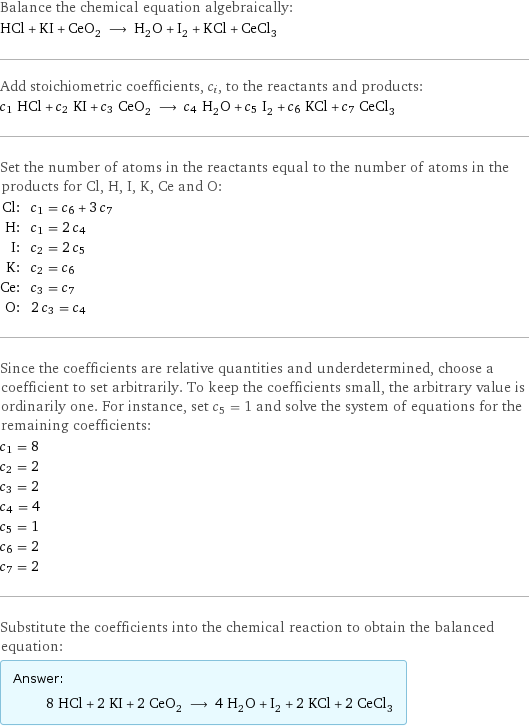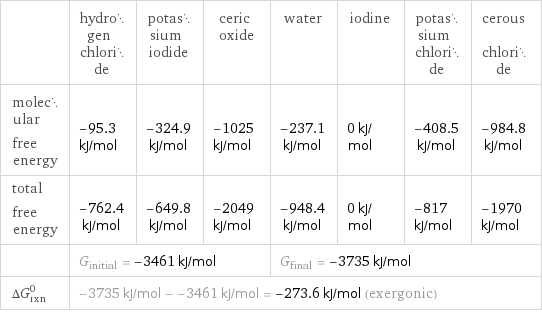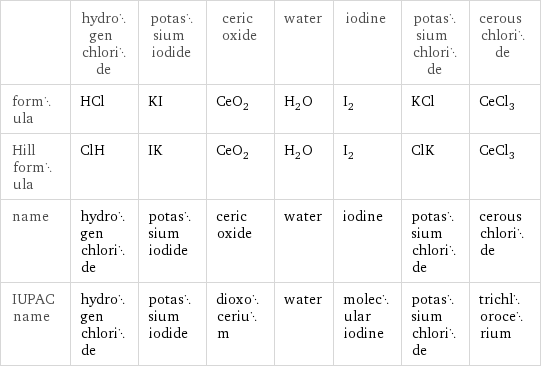Input interpretation

HCl hydrogen chloride + KI potassium iodide + CeO_2 ceric oxide ⟶ H_2O water + I_2 iodine + KCl potassium chloride + CeCl_3 cerous chloride
Balanced equation

Balance the chemical equation algebraically: HCl + KI + CeO_2 ⟶ H_2O + I_2 + KCl + CeCl_3 Add stoichiometric coefficients, c_i, to the reactants and products: c_1 HCl + c_2 KI + c_3 CeO_2 ⟶ c_4 H_2O + c_5 I_2 + c_6 KCl + c_7 CeCl_3 Set the number of atoms in the reactants equal to the number of atoms in the products for Cl, H, I, K, Ce and O: Cl: | c_1 = c_6 + 3 c_7 H: | c_1 = 2 c_4 I: | c_2 = 2 c_5 K: | c_2 = c_6 Ce: | c_3 = c_7 O: | 2 c_3 = c_4 Since the coefficients are relative quantities and underdetermined, choose a coefficient to set arbitrarily. To keep the coefficients small, the arbitrary value is ordinarily one. For instance, set c_5 = 1 and solve the system of equations for the remaining coefficients: c_1 = 8 c_2 = 2 c_3 = 2 c_4 = 4 c_5 = 1 c_6 = 2 c_7 = 2 Substitute the coefficients into the chemical reaction to obtain the balanced equation: Answer: | | 8 HCl + 2 KI + 2 CeO_2 ⟶ 4 H_2O + I_2 + 2 KCl + 2 CeCl_3
Structures

+ + ⟶ + + +
Names

hydrogen chloride + potassium iodide + ceric oxide ⟶ water + iodine + potassium chloride + cerous chloride
Reaction thermodynamics
Enthalpy

| hydrogen chloride | potassium iodide | ceric oxide | water | iodine | potassium chloride | cerous chloride molecular enthalpy | -92.3 kJ/mol | -327.9 kJ/mol | -1089 kJ/mol | -285.8 kJ/mol | 0 kJ/mol | -436.5 kJ/mol | -1061 kJ/mol total enthalpy | -738.4 kJ/mol | -655.8 kJ/mol | -2177 kJ/mol | -1143 kJ/mol | 0 kJ/mol | -873 kJ/mol | -2121 kJ/mol | H_initial = -3572 kJ/mol | | | H_final = -4137 kJ/mol | | | ΔH_rxn^0 | -4137 kJ/mol - -3572 kJ/mol = -565.7 kJ/mol (exothermic) | | | | | |
Gibbs free energy

| hydrogen chloride | potassium iodide | ceric oxide | water | iodine | potassium chloride | cerous chloride molecular free energy | -95.3 kJ/mol | -324.9 kJ/mol | -1025 kJ/mol | -237.1 kJ/mol | 0 kJ/mol | -408.5 kJ/mol | -984.8 kJ/mol total free energy | -762.4 kJ/mol | -649.8 kJ/mol | -2049 kJ/mol | -948.4 kJ/mol | 0 kJ/mol | -817 kJ/mol | -1970 kJ/mol | G_initial = -3461 kJ/mol | | | G_final = -3735 kJ/mol | | | ΔG_rxn^0 | -3735 kJ/mol - -3461 kJ/mol = -273.6 kJ/mol (exergonic) | | | | | |
Equilibrium constant
![Construct the equilibrium constant, K, expression for: HCl + KI + CeO_2 ⟶ H_2O + I_2 + KCl + CeCl_3 Plan: • Balance the chemical equation. • Determine the stoichiometric numbers. • Assemble the activity expression for each chemical species. • Use the activity expressions to build the equilibrium constant expression. Write the balanced chemical equation: 8 HCl + 2 KI + 2 CeO_2 ⟶ 4 H_2O + I_2 + 2 KCl + 2 CeCl_3 Assign stoichiometric numbers, ν_i, using the stoichiometric coefficients, c_i, from the balanced chemical equation in the following manner: ν_i = -c_i for reactants and ν_i = c_i for products: chemical species | c_i | ν_i HCl | 8 | -8 KI | 2 | -2 CeO_2 | 2 | -2 H_2O | 4 | 4 I_2 | 1 | 1 KCl | 2 | 2 CeCl_3 | 2 | 2 Assemble the activity expressions accounting for the state of matter and ν_i: chemical species | c_i | ν_i | activity expression HCl | 8 | -8 | ([HCl])^(-8) KI | 2 | -2 | ([KI])^(-2) CeO_2 | 2 | -2 | ([CeO2])^(-2) H_2O | 4 | 4 | ([H2O])^4 I_2 | 1 | 1 | [I2] KCl | 2 | 2 | ([KCl])^2 CeCl_3 | 2 | 2 | ([CeCl3])^2 The equilibrium constant symbol in the concentration basis is: K_c Mulitply the activity expressions to arrive at the K_c expression: Answer: | | K_c = ([HCl])^(-8) ([KI])^(-2) ([CeO2])^(-2) ([H2O])^4 [I2] ([KCl])^2 ([CeCl3])^2 = (([H2O])^4 [I2] ([KCl])^2 ([CeCl3])^2)/(([HCl])^8 ([KI])^2 ([CeO2])^2)](../image_source/f807575aa3ccba89812caf353e1a38ce.png)
Construct the equilibrium constant, K, expression for: HCl + KI + CeO_2 ⟶ H_2O + I_2 + KCl + CeCl_3 Plan: • Balance the chemical equation. • Determine the stoichiometric numbers. • Assemble the activity expression for each chemical species. • Use the activity expressions to build the equilibrium constant expression. Write the balanced chemical equation: 8 HCl + 2 KI + 2 CeO_2 ⟶ 4 H_2O + I_2 + 2 KCl + 2 CeCl_3 Assign stoichiometric numbers, ν_i, using the stoichiometric coefficients, c_i, from the balanced chemical equation in the following manner: ν_i = -c_i for reactants and ν_i = c_i for products: chemical species | c_i | ν_i HCl | 8 | -8 KI | 2 | -2 CeO_2 | 2 | -2 H_2O | 4 | 4 I_2 | 1 | 1 KCl | 2 | 2 CeCl_3 | 2 | 2 Assemble the activity expressions accounting for the state of matter and ν_i: chemical species | c_i | ν_i | activity expression HCl | 8 | -8 | ([HCl])^(-8) KI | 2 | -2 | ([KI])^(-2) CeO_2 | 2 | -2 | ([CeO2])^(-2) H_2O | 4 | 4 | ([H2O])^4 I_2 | 1 | 1 | [I2] KCl | 2 | 2 | ([KCl])^2 CeCl_3 | 2 | 2 | ([CeCl3])^2 The equilibrium constant symbol in the concentration basis is: K_c Mulitply the activity expressions to arrive at the K_c expression: Answer: | | K_c = ([HCl])^(-8) ([KI])^(-2) ([CeO2])^(-2) ([H2O])^4 [I2] ([KCl])^2 ([CeCl3])^2 = (([H2O])^4 [I2] ([KCl])^2 ([CeCl3])^2)/(([HCl])^8 ([KI])^2 ([CeO2])^2)
Rate of reaction
![Construct the rate of reaction expression for: HCl + KI + CeO_2 ⟶ H_2O + I_2 + KCl + CeCl_3 Plan: • Balance the chemical equation. • Determine the stoichiometric numbers. • Assemble the rate term for each chemical species. • Write the rate of reaction expression. Write the balanced chemical equation: 8 HCl + 2 KI + 2 CeO_2 ⟶ 4 H_2O + I_2 + 2 KCl + 2 CeCl_3 Assign stoichiometric numbers, ν_i, using the stoichiometric coefficients, c_i, from the balanced chemical equation in the following manner: ν_i = -c_i for reactants and ν_i = c_i for products: chemical species | c_i | ν_i HCl | 8 | -8 KI | 2 | -2 CeO_2 | 2 | -2 H_2O | 4 | 4 I_2 | 1 | 1 KCl | 2 | 2 CeCl_3 | 2 | 2 The rate term for each chemical species, B_i, is 1/ν_i(Δ[B_i])/(Δt) where [B_i] is the amount concentration and t is time: chemical species | c_i | ν_i | rate term HCl | 8 | -8 | -1/8 (Δ[HCl])/(Δt) KI | 2 | -2 | -1/2 (Δ[KI])/(Δt) CeO_2 | 2 | -2 | -1/2 (Δ[CeO2])/(Δt) H_2O | 4 | 4 | 1/4 (Δ[H2O])/(Δt) I_2 | 1 | 1 | (Δ[I2])/(Δt) KCl | 2 | 2 | 1/2 (Δ[KCl])/(Δt) CeCl_3 | 2 | 2 | 1/2 (Δ[CeCl3])/(Δt) (for infinitesimal rate of change, replace Δ with d) Set the rate terms equal to each other to arrive at the rate expression: Answer: | | rate = -1/8 (Δ[HCl])/(Δt) = -1/2 (Δ[KI])/(Δt) = -1/2 (Δ[CeO2])/(Δt) = 1/4 (Δ[H2O])/(Δt) = (Δ[I2])/(Δt) = 1/2 (Δ[KCl])/(Δt) = 1/2 (Δ[CeCl3])/(Δt) (assuming constant volume and no accumulation of intermediates or side products)](../image_source/b0299ae721d710713b47809914955f26.png)
Construct the rate of reaction expression for: HCl + KI + CeO_2 ⟶ H_2O + I_2 + KCl + CeCl_3 Plan: • Balance the chemical equation. • Determine the stoichiometric numbers. • Assemble the rate term for each chemical species. • Write the rate of reaction expression. Write the balanced chemical equation: 8 HCl + 2 KI + 2 CeO_2 ⟶ 4 H_2O + I_2 + 2 KCl + 2 CeCl_3 Assign stoichiometric numbers, ν_i, using the stoichiometric coefficients, c_i, from the balanced chemical equation in the following manner: ν_i = -c_i for reactants and ν_i = c_i for products: chemical species | c_i | ν_i HCl | 8 | -8 KI | 2 | -2 CeO_2 | 2 | -2 H_2O | 4 | 4 I_2 | 1 | 1 KCl | 2 | 2 CeCl_3 | 2 | 2 The rate term for each chemical species, B_i, is 1/ν_i(Δ[B_i])/(Δt) where [B_i] is the amount concentration and t is time: chemical species | c_i | ν_i | rate term HCl | 8 | -8 | -1/8 (Δ[HCl])/(Δt) KI | 2 | -2 | -1/2 (Δ[KI])/(Δt) CeO_2 | 2 | -2 | -1/2 (Δ[CeO2])/(Δt) H_2O | 4 | 4 | 1/4 (Δ[H2O])/(Δt) I_2 | 1 | 1 | (Δ[I2])/(Δt) KCl | 2 | 2 | 1/2 (Δ[KCl])/(Δt) CeCl_3 | 2 | 2 | 1/2 (Δ[CeCl3])/(Δt) (for infinitesimal rate of change, replace Δ with d) Set the rate terms equal to each other to arrive at the rate expression: Answer: | | rate = -1/8 (Δ[HCl])/(Δt) = -1/2 (Δ[KI])/(Δt) = -1/2 (Δ[CeO2])/(Δt) = 1/4 (Δ[H2O])/(Δt) = (Δ[I2])/(Δt) = 1/2 (Δ[KCl])/(Δt) = 1/2 (Δ[CeCl3])/(Δt) (assuming constant volume and no accumulation of intermediates or side products)
Chemical names and formulas

| hydrogen chloride | potassium iodide | ceric oxide | water | iodine | potassium chloride | cerous chloride formula | HCl | KI | CeO_2 | H_2O | I_2 | KCl | CeCl_3 Hill formula | ClH | IK | CeO_2 | H_2O | I_2 | ClK | CeCl_3 name | hydrogen chloride | potassium iodide | ceric oxide | water | iodine | potassium chloride | cerous chloride IUPAC name | hydrogen chloride | potassium iodide | dioxocerium | water | molecular iodine | potassium chloride | trichlorocerium